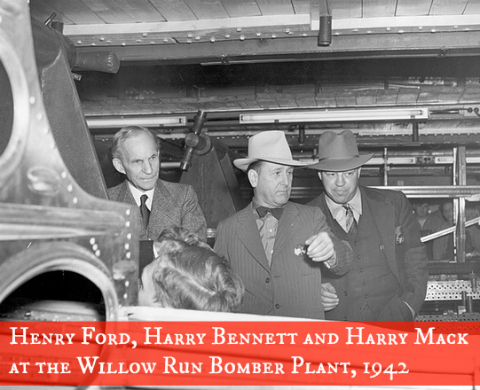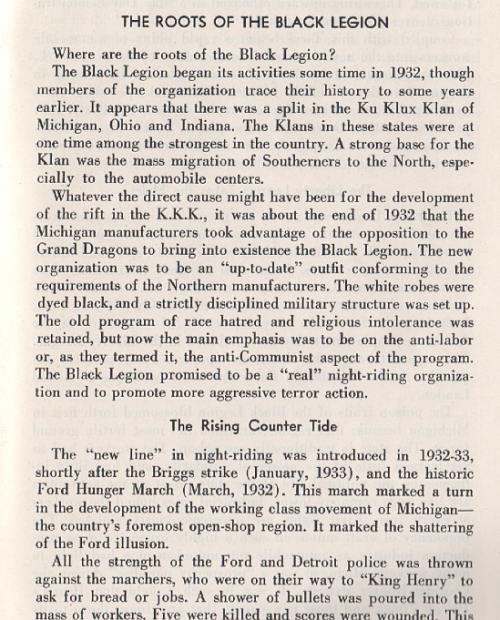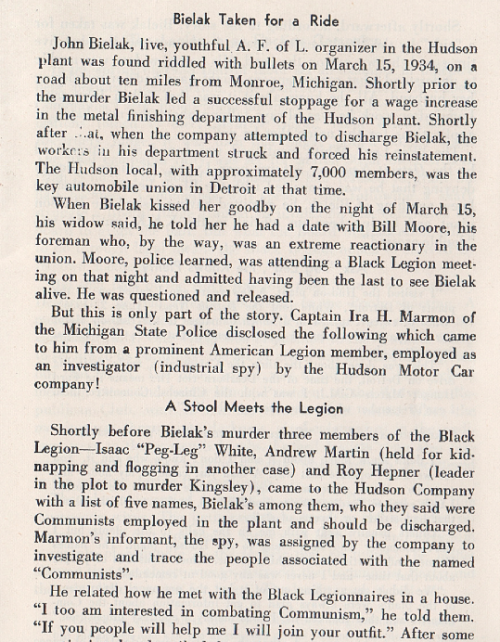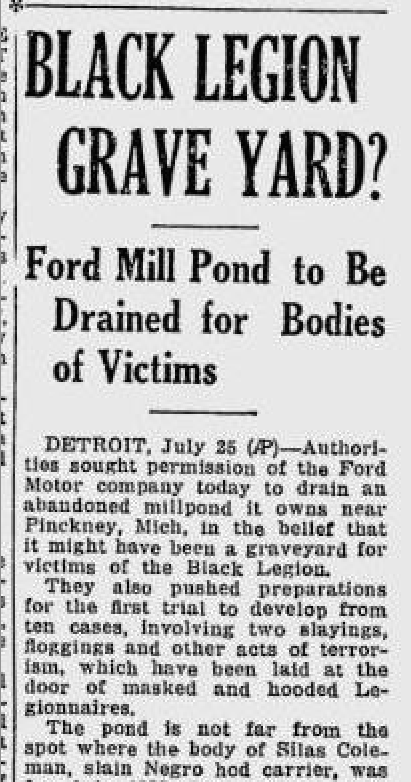Every now and again, as I’ve written about him a few times in the past, I get an odd call about infamous Ford enforcer Harry Bennett, who built a fortress not far from here in 1930 to protect him from his many enemies. Not too long ago, as you might recall, a man contacted me from Palm Springs, where Bennett retired about 50 years ago, wanting to share photos of paintings that he’d been given by the former head of Ford security as a kid. [Bennett had taken up painting in his retirement, and this man had grown up next door to him, helping him around his house.] And, just a few days ago, I was asked by a man if I’d like to talk with his 96 year old father about the secret tunnels that run beneath the estate off of Geddes that Bennett built in 1930. [The tunnels, as I understand it, were built years later, after Bennett escaped a failed murder attempt.] Apparently, from what I’m told, his father built the tunnels, and has stories that he’s ready to share. [Hopefully they involve the lions Bennett supposedly kept in the tunnels to thwart his potential assassins.] So tonight I’m doing research on the house, its tunnels, and the stories of labor organizers who may have met their end on the property, as I have no idea where this discussion may lead.

For those of you who may never have heard of Bennett (seen above with Henry Ford), here’s something I posted a while back that should give you a pretty good idea of the man.
According to legend, Henry Ford hired Bennett, a former Navy man, after having seen him kick someone’s ass on the streets of New York. He was apparently just the kind of man that Henry wanted, a brutal enforcer who could take care of “problems” within Ford at a point in history when organized labor was becoming a force to be reckoned with. Bennett came to head Ford’s “Service” Department, which was essentially a private army within the company comprised of the most cruel hoodlums and ex-convicts that money could buy. The men of the Service Department, under Bennett’s direction, made sure that the plants kept running efficiently, no matter what the cost… Word is that Hitler’s Gestapo was modeled after the Ford Service Department, so that should give you some sense of what they were like.
Coincidentally, during this same time in Michigan, there arose a political organization known as the Black Legion. A splinter group of the KKK, the Black Legion was dedicated to stopping Communism in all of its forms, especially, it would seem, through the killing of men organizing workers in Ford plants… Following are two clips from a pamphlet published in 1936 titled The Black Legion Rides, which touch on some of the connections between Ford and the Legion.
Interestingly, the Black Legion was known to have dumped bodies on a property near Pinkney owned by Ford… Even more interestingly, Ford and Bennett refused to cooperate when authorities asked for permission to drain the mill pond and search for additional bodies in the summer of 1936, after the body of a man was found on the property, and interviews led the police to think that there were others.
And, here, for those of who who still want more, is a clip from the book The Arsenal of Democracy: FDR, Detroit, and an Epic Quest to Arm an America at War.
Henry Ford was relaxing in a New York hotel room one day when he met a man named Harry Bennett. He was a little figure — five-foot-seven, 145 pounds, with hard blue eyes, receding brown hair, and a bulldog jaw. The New York Times columnist Arthur Brisbane introduced the two. Bennett was from Ann Arbor, Michigan, not far from where Henry lived. The twenty-four-year-old was just out of the navy, where he had served as a deep-sea diver and had boxed under the name “Sailor Reese.”
Henry took a liking to Bennett. The little man had sly eyes that were calculating and fearless and a picaresque past that made him sound like a character out of a gritty detective novel. Every scar on his face had a story. Harry Bennett had learned to brawl as a kid from his father. In fact, his father had been killed in a barroom fight.
“I could use a man like you at the Rouge,” Henry said. “Can you shoot?”
“Sure I can,” said Bennett.
The men at the Rouge were “a pretty tough lot,” Henry said. “I haven’t got any policemen out there.”
Soon after, Henry hurled Bennett into the iron jungle. “There may be a lot of people over there who want to fire you,” he told Bennett, “but don’t pay any attention to them. I’m the only one who can fire you. Remember, you’re working for me.”
Born in 1892, Bennett was a year older than Henry’s son Edsel. In his basement office in the Rouge, he kept a small desk, a fireplace, and a couch. He hung a picture of his daughter on the wall. Other than that, the office was spare. It had two doors, one in front of him controlled by a button under his desk, and another secret door behind him so that Henry could come and go without being noticed. Bennett hung a target in his office for .32 caliber target pistols. He and his boss Henry sat for hours firing away. According to Bennett, “Mr. Ford was a dead shot.”
Each morning Bennett dressed in a suit, his trademark bow tie (a hanging tie could be grabbed and used in a fight), a fedora, and a holster in which he packed a handgun at all times. He picked up Henry at his Fair Lane estate and took him to work. Whatever Henry needed done, Bennett was there for the doing. The fact that he couldn’t change the oil of an automobile stirred confusion among the ranks. When asked what his job was, Bennett answered, “I am Mr. Ford’s personal man.” And then: “If Mr. Ford told me to blacken out the sun tomorrow, I might have trouble fixing it. But you’d see a hundred thousand sons-of-bitches coming through the Rouge gates in the morning, all wearing dark glasses.”
Henry paid Bennett “peanuts for a salary,” according to the ex-navy man. But he had access to a safe full of cash for special expenses. He moved into a winged Gothic home owned by Henry on the Huron River in nearby Ypsilanti, where he threw wild parties and showed pornographic films with titles like “The Casting Director” and “A Stiff Game.” He called his home “The Castle.”
In the 1920s, Bennett began to amass a private security force called the Service Department — a group of ex-boxers and ballplayers, cons, bad cops kicked off the force, and characters from Detroit’s La Cosa Nostra, which during Prohibition ran a thriving booze trade, smuggling liquor over the Detroit River from Canada. Service Department men were noticeable for their size, rough language, and cauliflower ears, and for the fact that they hung around without doing any work.
“They’re a lot of tough bastards,” Bennett described his burgeoning Gestapo, “but every one of them is a goddamn gentleman”…
Harry Bennett found opportunity in the Depression. As head of personnel, Bennett ruled the Rouge. People were desperate for work. If a man wanted a job — well, then, maybe he’d have to do somebody a favor. Maybe he’d have to vote a certain way in an election. Maybe he would have to wax one of Harry Bennett’s yachts, if he didn’t want to get his teeth knocked out. By 1937, Bennett had succeeded in building the Service Department into what H. L. Mencken’s American Mercury magazine called “the most powerful private police force in the world.”
“There are about eight hundred underworld characters in the Ford Service Department,” labor leader Benjamin Stolberg said. “They are the Storm Troops. They make no pretense of working, but are merely ‘keeping order’ in the plant community through terror.”
Among the Service Men employed by Bennett: Norman Selby, an ex-pugilist who fought as “Kid McCoy,” married ten times, paroled to Bennett after serving twenty years for murdering his sweetheart. Joseph “Legs” Laman, admitted serial kidnapper, nicknamed for his ability to evade the law on foot. Joe Adonis, a mobster called by the New York Post “a gang punk” and “dope king.” Sicilian mob boss Chester LaMare, the “Al Capone of Detroit,” who controlled Detroit’s waterfront during Prohibition. Former journeyman pugilist Elmer “One Round” Hogan, Sicilian gangster Joe Tocco, Jack Dempsey’s former manager Leonard Saks…
Under constant intimidation by Bennett’s Service Men — the “Ford Terror” — workers at the Rouge suffered nervous breakdowns and an anxiety-induced ailment known as “the Ford stomach.” “I think it was just fear that caused this tension in the company,” recalled engineer Roscoe Smith. “A lot of people, when [Bennett’s men] came around and started taking them apart, just couldn’t take it. They couldn’t stand the pressure.”
Meanwhile, the speed of the assembly line increased…
So, wish me luck. If all goes well, I should have new stories later this week of what it was like to work for Bennett and dig his tunnels.















9 Comments
Assuming Bennett told him about his plans to have lions housed at the tunnel entrance, I’d be curious to know what his father made of that at the time. I’m trying to imagine what my response would be if I sat down with a potential client and he told me that I’d be building an underground warren populated by wild beasts intended to eat my adversaries.
For what it’s worth, Bennett was said to paint before retirement. I’ve heard that he painted his pet lions while living at the castle.
“So tonight I’m doing research on the house, its tunnels, and the stories of labor organizers who may have met their end on the property, as I have no idea where this discussion may lead.”
… Hoffa, right? It’s always Hoffa. :)
(Seriously sounds awesome)
Did he just dig tunnels, or did he also dig graves?
I think I toured this house circa 1991. It is in the rural area near Geddes Ave east of Huron Parkway. The land surrounding it was wild and overgrown but had at one time been something of a park. There was a pond, I think, and also a miniature village similar to what you might have seen at a miniature golf course.
Harry Bennett also built tunnels underground in his Grosse Ile Pagoda House and used it to run liquor from Canada.
Harry’s kids went to Roosevelt School in Ypsi. My father remembered the chauffeured limousine that dropped them off and picked them up. He was afraid the girls would be kidnapped so kept a close eye on them in the 1930s…
I was in the Pagoda House Tunnels underneath West River Road from the tool shed which was about a half mile away in 1976 on a drunken dare, as a kid- they had water in them and were concrete lined. We broke in one night in high school. Super creepy and scary with the water and no lighting :)
I gather that they used to run booze for all the car folks on the island although my parents said Henry F wasn’t a drinker. As the river was cleaner then, it also froze. I cannot recall which teacher in Jr. High told me some islanders took cars over-probably a main income source for that plant. I gather the plant has now closed.
We lived in one of the three houses on West River over the water (which is now illegal to build that way), supported on 12 by 12 walnut pilings which were rot resistant. Lots of black walnut left over from the 1918 war never used for gun stocks. All three W R houses were washed a bit in the 1952 flood. I haven’t any idea if the P got it or was able to clear water-it wasn’t built like ours. Definitely the tunnel would have been flooded. It MAY be that the Ile Camera archives has some gossip on if the Fishers and Olds people were in on this or not